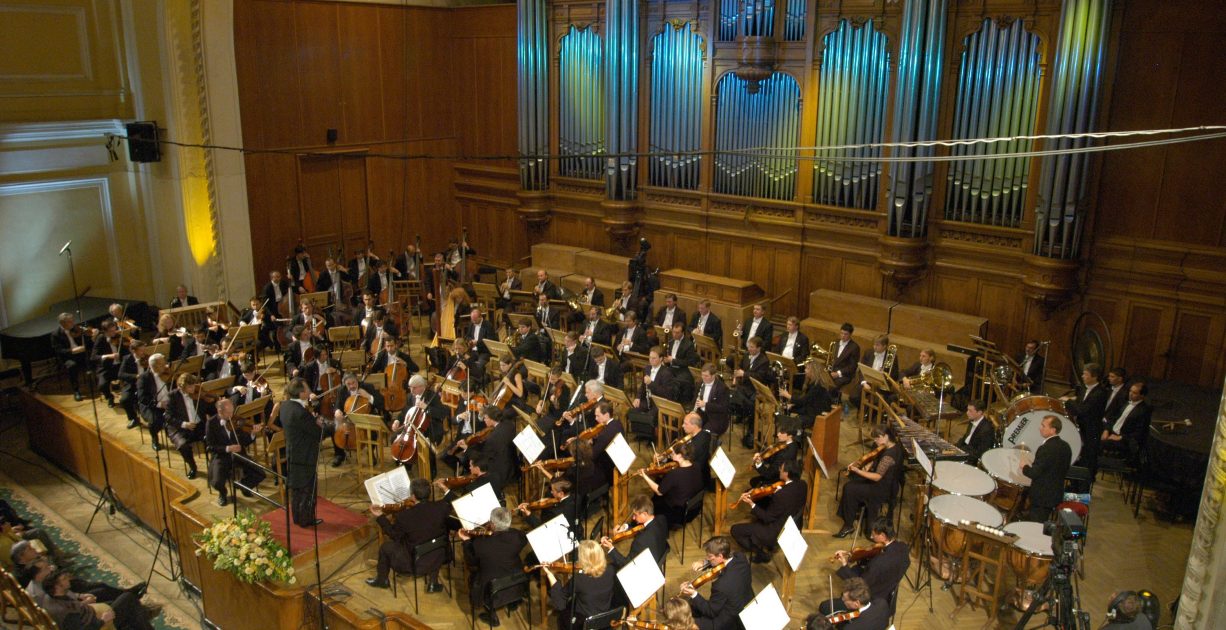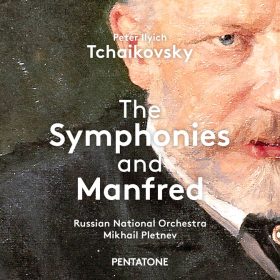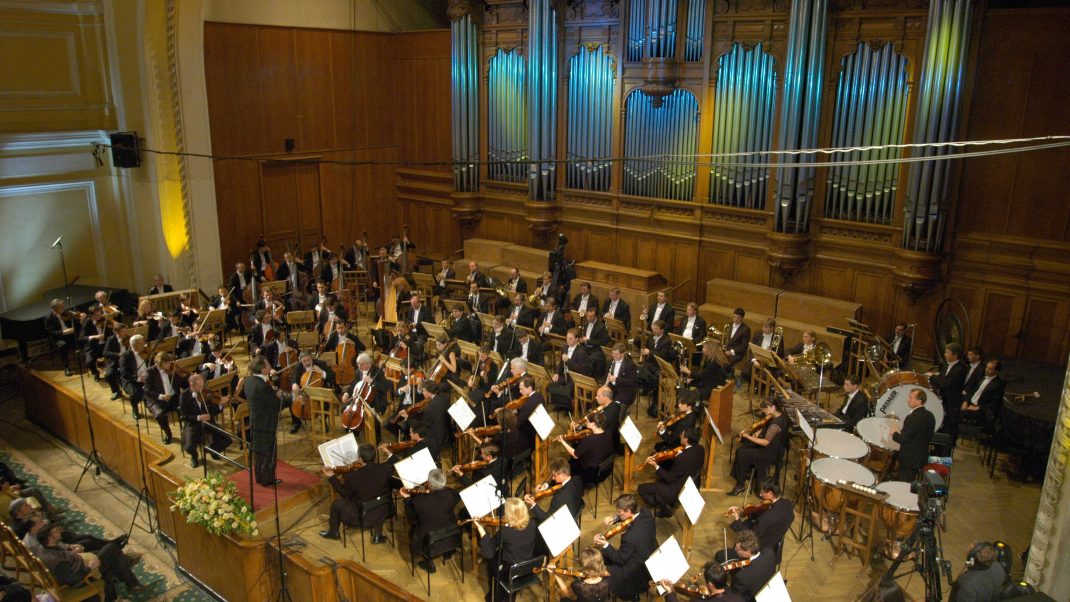“This is the most exciting Tchaikovsky cycle out there, and it beats the earlier DG set both for thrills and for the quality of the recorded sound.”
We are thrilled to share with you that our Tchaikovsky box, “Tchaikovsky The Symphonies and Manfred” with Mikhail Pletnev and the Russian National Orchestra received a fantastic review and chosen to be the Recording of the Month on Music Web International! The review wonderfully described the extensive details of Mikhail Pletnev’s superlative interpretation and the greatness of the Russian National Orchestra:
Mikhail Pletnev and the Russian National Orchestra have already recorded the complete Tchaikovsky symphonies with Deutsche Grammophon, and to do so again for Pentatone seems to suggest largesse not seen since the days of Karajan. So is it worthwhile? The answer is a clear yes. This is the most exciting Tchaikovsky cycle out there, and it beats the earlier DG set both for thrills and for the quality of the recorded sound.
One of the most distinctive things about this set, and one of the things that sets it out as interesting, is Pletnev’s preference for fast tempi. That repeatedly injects an extra element of excitement into the music which others often lack; and it is matched with stunningly virtuosic orchestral playing so that there is never any danger of coming off the rails. However, the one place where you won’t hear that preference for fast tempi is in the very first track on the set. The opening of No. 1 unfolds much more slowly than you might expect, but here you hear amply this box’s two biggest selling points: the rich, resonant, utterly characteristic Russian playing, and the gloriously full Pentatone sound. Listen to the way the violins first tremble beneath the frosty winds, then soar in the second subject; or the way the sound seems so open and transparent as to have the effect of beaming an X-Ray through the score. The balance is just about ideal, with brass clear and distinct without ever dominating, and both winds and strings sitting perfectly within the soundscape. It’s a delightful mix, and demonstrates the best that this team (conductor, orchestra and producer) can do. Pentatone’s surround sound is glorious, and you don’t even have to listen in SACD to pick it up: the stereo picture is remarkably, stunningly clear. I might even go so far as to say that this is the best sounding Tchaikovsky cycle out there, and I suspect that was the main thing the lured Pletnev and the RNO back into the recording studio for this repertoire.
Pletnev shows himself to be particularly sensitive to the changes in Tchaikovsky’s style, and he handles them very well. For example, he doesn’t attempt to conduct No. 1 as though it were the Pathétique – in fact, he embraces it as the slightly episodic work that it is and he seems to enjoy bringing out the child-in-a-sweetshop aspects of the symphony’s exploratory immaturity. However, if Pletnev doesn’t conduct it like the Pathétique, then his orchestra plays it as though it were. The same lush string tone that they lavish on the great late symphonies is also on display in the less mature works. Listen, for example, to the gorgeous blanket of sound that opens the slow movement of No. 1, or the tailor-made violin tone of the Scherzo that steers a halfway house between brightness and mystery. Likewise, the gorgeous wind solos of the Adagio (or the introduction to the Finale) would not be out of place in the slow movement of No. 4, and the verve of the finale seems to look forward to the composer’s later works.The slow introduction of No. 2 is hugely exciting, full of anticipation of a cracking Allegro, and, again, contains some fantastic solos, all of which are brought to life in magnificently clear sound. There is a real impetus to the ensuing Allegro, full of a bite and passion that sounds unmistakably Russian (though I wonder if I’d be saying that if I didn’t know who the players are?). The Andante Marziale is splendidly perky, and daringly fast, as is the Scherzo, which rollicks along brilliantly. The finale then crowns the symphony with a reading of tremendous energy that also serves to remind you of what a great orchestrator Tchaikovsky could be. The breadth of the sound is magnificent here, too, right from the slow opening through to the crash of the gong and the hell-for-leather coda, helped by the slightly cheeky but utterly forgivable way that Pletnev pulls the tempo around. It’s the kind of Tchaikovsky sound that makes your scalp prickle. As a bonus you also get the original version of the first movement (before Tchaikovsky revised it in 1880). The introduction is pretty much identical, but the main body of the movement is a lot slower and less exciting, even though it uses lots of the same themes. It’s interesting, but this recording is good enough not to need that as a USP.
No. 3 has a wonderfully oblique introduction whose mood really could swing either way; and you can sense the delight as it ultimately dissolves into the main allegro, whose light-hearted ebullience is relished by the players as they take every opportunity to let their musical hair down, reminding us that this, after all, is Tchaikovsky’s only major key symphony. Meltingly sweet oboe and flute solos are there in the second subject to remind us that the melancholy is not altogether banished, but bright trumpets and busy strings, as well as Pletnev’s direction, ensure that an upbeat mood is kept firmly to the fore. The second movement is, quite rightly, only a hop-skip-and-a-jump away from the world of the ballets, and Pletnev doesn’t allow symphonic weight to overwhelm the music’s inherent sense of style and movement. The Andante opens wistfully in the winds, but that’s a mere prelude to the heart-rending string tone that takes over around the 3-minute mark, playing the like of which you just don’t get in Berlin or Vienna, let alone in London. That lends this central movement a weight and intensity that, bluntly, it barely deserves, but I was utterly sold. The filigree bustle of the fourth movement is delightfully precise (with a fantastic trombone solo towards the end), and the Polonaise finale still manages to feel like a dance movement, for all its added weight. In fact, it feels like the most energetic movement in the symphony, and there is a gleeful swagger to each reappearance of the main theme (and its contrapuntal variants), to which the interludes provide delicately drawn contrast. The final peroration is (almost) as thrilling as the one that ends Symphony No. 2, and there are few recordings about which you can say that.
I had expected the fanfares at the start of No. 4 to pin me to the back of my seat a bit more than they did, but Pletnev’s tactic is to make the violins’ first theme the centre of attention. Again, it’s faster than normal, adding weight to the idea of fate as a malign propulsive force, driving the action forward, to the extent that even the gentler second theme is affected. Towards the end of the rocking third theme, Pletnev increases the tempo steadily, inexorably, almost imperceptibly so as to build up the excitement in such a way that the start of the development feels like plunging into a cauldron of despair; something which, after an initial lull, is only intensified as the development builds into the recapitulation. This is playing and atmosphere that can stand comparison with Abbado, Gergiev and, perhaps more pertinently, Mravinsky; and that is high praise. The strings are hair-raising in the coda. The Andantino flows, never wallows, and the bright-as-a-button winds steal the show in the Scherzo. The quicker tempo makes the finale an exhilarating thrill ride to the extent that, in the hands of different musicians, you’d be worried about the music coming off the rails altogether! No such danger here. The coda will bring you to your feet if you’re not already standing, and even in the tumult of the final bars, as Pletnev drives the tempo over a cliff, important details like the piccolo and triangle remain crystal clear.
The clarinet solo that gives out the Fate theme at the beginning of No. 5 is oh-so-subtle, as if engaged in an against-the-odds conversation with string section, and the speed of the main Allegro is fast in a way that makes it feel like a march. The violins are warm and persuasive in the second subject, leading to an exciting – and rather optimistic – climax. There is then a real punch to the coda with its staccato brass, before sinking quietly into nothingness. The (excellently played) horn solo in the slow movement is distinctively Russian: lacking the central European glow, it sounds fairly close to a euphonium in its lower registers, which will be a matter of taste, but it’s certainly in keeping with the rest of the reading. The rest of the movement is beautifully lyrical, with sweeping strings and characterful wind solos, so that the brass punctuations of the Fate theme are all the more striking. The waltz is very winning, with admirable precision in the central scampering section, but the finale will be a Marmite movement for many people because Pletnev’s tempi are so inconsistent. He opts for extremes of slow and fast, and pulls things around all over the place, not just between sections but even within them. I was just about won over by the sheer excitement of the results, but I can understand why, if you’d heard this Fifth in isolation from the rest of the set, you’d think it was wilful and inconsistent.
For the Pathétique, perhaps the climax of the cycle, Pletnev paces the first movement as though it were a psychological thriller (which, let’s face it, it is!). Extremes, both of tempo and dynamics, help not only to build the tension but to propel the drama forwards: the opening kick of the development hits you like a punch in the stomach, and the slowdown before the reappearance of the consoling string theme is volcanic in its intensity, the trombones ringing out like the Apocalypse. The second movement is steady-as-she-goes, while the March, taken at a cracking pace, builds wave upon wave of excitement unto the final bars. The finale then opens in utter doom, and I don’t think I’ve ever heard the contribution of the horns so clearly drawn as here. The major key second theme seems to bear the movement forwards, wave upon wave, but the devastation of the final climax is total, all the more devastating for its seeming inevitability. The power of the gong and trombones, and the darkness of the final string fade will live in my memory for a long time, with the bass pizzicati seeming like the final nails in the coffin. My only criticism is their putting Capriccio Italien straight after it on this disc: you have to reach for the stop button pretty quickly if you’re to avoid the mood of the symphony’s conclusion being utterly shattered.
There is a neat contrast, at the beginning of Manfred, between the choir of winds and the torrent of strings, both of which conjure up soulfulness and weight in entirely different ways. This is a tricky work to get right, partly because the architecture is more problematic than in the numbered symphonies, and Pletnev does a good job of managing the ebb and flow as anyone else. The violence of the first movement’s Manfred music melts very convincingly into the (beautifully played) music for Astarte, and the all-important harp in this section sounds as clear as a bell, while the final section, with surging, dark cellos, sinister trombones and thrilling horns is electrifying. The Alpine fairy is depicted with precision and brightness in the Scherzo (it vanishes into thin air magnificently at the end), and the central string theme is beautifully lyrical. The tonal colour of the third movement is (correctly) utterly different to the others: the pastoral beauty of the opening leads inexorably through an ever darkening soundscape to the appearance of Manfred’s theme, and the reappearance of the bucolic earlier themes feels rather less convincing the second time around. Energy levels are high in the problematic finale, though they are somewhat (and inevitably) sapped by the reappearance of the themes from the first movement. The fugue cannot wholly solve this problem, and the ending is unavoidably tricky; but the entry of the organ sounds great, and the wind choir at the end seems to invoke the work’s opening in a pleasing symmetry.
The extras are all done very well too. Marche Slave is on the fast side, but this injects it with a certain level of energy that few recordings achieve. The ending eschews all subtlety, and is all the better for it! Likewise, Pletnev is not afraid of the Crash-Bang-Wallop elements of the 1883 Coronation March, though not even he can prevent it sounding just a little cheap. Romeo and Juliet is given a genuinely classy, albeit very driven reading. The energy of the fight music is so all-encompassing that it threatens to engulf the love music. Pletnev just about avoids this by broadening out the tempo incredibly at the climax of the love theme, and the wind chorale in the finale is very beautiful, the harp chords drifting upwards magically at the end. The grandeur of Francesca da Rimini is apparent right from the opening chords, and the sense of space opened up around the winds’ groanings is awesome, evoking the very caverns of hell. The storm is vigorous (and terrifying in the coda) while the love music is most involving, albeit too rushed at the climax. The Capriccio Italien is tremendous fun, too, the brightness of the sound really adding to the sense of Mediterranean colour and, in this of all works, Pletnev’s extreme tempi really help it to take off.
So where does this set stand in the overall catalogue? Pretty near the top, in my view. It’s better than Pletnev’s earlier DG version because of the surround sound and the faster tempi. If you compare them back to back then there is not, perhaps, too much in it; but the Pentatone one just feels different, with more get-up-and-go to it, which renders this one much more exciting and the DG one perhaps the safer bet. Among other complete cycles, the virtuosity of the playing, combined with the energy of the reading, put it ahead of Karajan or Masur (Gewandhaus, Warner), let alone Litton in Bournemouth, for all the virtues of that set. Among conductors who have not (yet) set down the first three, Gergiev’s Vienna set is remarkable as, for entirely different reasons, is Mravinsky’s Leningrad set. However, the main rival to this one among complete cycles is, surely, Mariss Jansons’ Oslo set (Chandos CHAN8672M). It was through this set that I first got to know Manfred and the earlier works, and it still sounds astoundingly fresh today. In many ways, Jansons is the greatest example of orthodoxy, while Pletnev on Pentatone represents the best of the current Russian school. Jansons does have price on his side at present, but Pletnev has the new sound technology.One of the downsides of having such excellent recorded sound, by the way, is that, during the quieter passages, you can frequently hear Pletnev groaning on the podium, but unless you’re hyper-sensitive to that sort of thing it shouldn’t get too much in the way; and he’s a lot less audible than are the likes of Pappano and Gergiev.
Photo Credit: RNO





